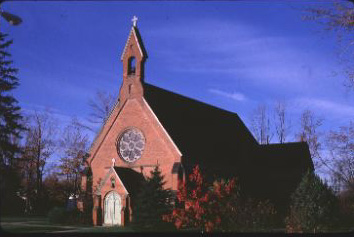Christ Church162 South Main, 1856-9 |

The building of Christ Church marked the arrival of religious pluralism in Oberlin. With First Church it is one of the rare institutional structures to survive from the pre-Civil War era. Episcopalians began to hold meetings in Oberlin as early as 1852. Three years later a parish was formally organized with help from Rev. Francis Granger of St. Andrews, Elyria. Work on a place of worship, slowed by scarce funds, was completed in 1859. Granger secured plans from Frank Wills, an English -born architect who had come to New York City via Canada a decade before.
Wills was an important missionary for the spread of the Gothic Revival in America, and Episcopal churches were a superb agency for the cause. Episcopalians, like their Anglican counterparts, habitually associated Christianity with the Gothic tradition and mistrusted the pagan aura of Greek and Roman architecture which had dominated popular taste in the United States since the American Revolution. Wills's design for Oberlin adapted Gothic complexity to the needs of a struggling village parish. Exterior brickwork was used with economy and candor to articulate the main structural arrangements. The round arches of the windows and vestibule (the latter added in 1867) as well as the barrel vaulting of the interior strike a Romanesque note, enforcing a mood of sturdy modesty about the church.
Hard times hit Oberlin Episcopalians in the 1880s when for years they went without a rector or regular services, and in the 1970s when the parish survived a stormy quarrel over the ordination of women as priests.
The windows of the church date from the twentieth century. On the south wall of the nave is a window created in 1901 by artist Kenyon Cox and dedicated to his father Jacob Dolson Cox, an Oberlin graduate who served as a Union army general, governor of Ohio, and cabinet member to Ulysses Grant in the 1860s. The other windows, including the rose window in the east front, were designed by Margaret Kennedy, an artist in the parish, and installed between 1955 and 1960.
Christ Church is on the National Register.
(Blodgett 81-82)
For more information about Christ Church and its history, please click here.